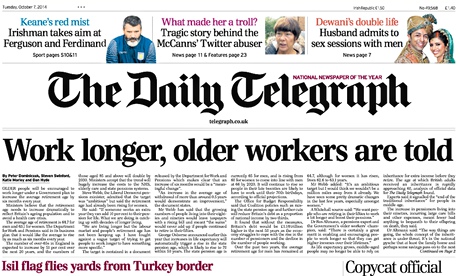
Telegraph Media Group is this week implementing a radical restructure of its editorial operation to focus on using digital content as the backbone of each printed edition of the Daily Telegraph.
In a series of “town hall” meetings with staff Jason Seiken, Telegraph Media Group editor-in-chief, last week unveiled an acceleration of his vision to transform the organisation’s print-focused mindset into a digitally led approach.
Seiken and top TMG executives have “cherry picked” ideas from newspapers in North America and Europe, most notably Germany’s Die Welt, to introduce new editorial practices and a new production system.
Several sources said the new production system will have the biggest impact, with one describing it as a “templatised” system, so that a relatively small team can produce the newspaper by dropping web content into pre-designed pages.
“The most substantial change I saw [in the briefings] was the creation of a central production department that will mostly treat online as a ‘buffet’ to fill the paper,” said a second source. “Although it has been made clear the paper will still have elements like exclusive news and comment.”
A third source said that the strategy is a “step change” beyond the concept of “digital first”.
“The engine driving the content decisions is the 80 million worldwide unique users per month. But readers of the newspaper will not notice a difference, the paper is still a crown jewel.”
Staff have been told to embrace a new editorial ethos with five main elements:
• One integrated print/digital newsroom.
• Two shifts worked each day, one from 6am and one ending at midnight.
• Three speeds to work at, from fast for breaking news to slower for a feature.
• Four key skills for each journalist: social, video, analytics and search engine optimisation.
• Five deliverable ideas required from each desk each day: including one video, one shareable and one interactive.
There is also a push for journalists to use more interactive elements with news stories, although one source denied that staff have been told they are using “too many words”. “To win in the digital space it is all about data,” said one source.
In the last two weeks data analytics tool Parse.ly has been rolled out to journalists. Telegraph Media Group has also taken a 25% stake in data journalism company FactMint.
With this approach in mind the main daily news conference has been moved to the earlier time of 8am, with the first 15 minutes led by Gregg Stewart, director of audience development. “It is mashing digital natives and journalists,” said one source.
Seiken is also understood to be adding a more commercial aspect to his role as editor-in-chief, looking into developing new revenue streams in areas such as e-commerce.
One source said that it is in no way similar to the ill-fated Project Euston, the brainchild of former editor-in-chief Will Lewis, which was set up as a standalone entity to explore digital revenue opportunities but folded within a year.
• To contact the MediaGuardian news desk email media@theguardian.com or phone 020 3353 3857. For all other inquiries please call the main Guardian switchboard on 020 3353 2000. If you are writing a comment for publication, please mark clearly “for publication”.
• To get the latest media news to your desktop or mobile, follow MediaGuardian on Twitter and Facebook.

